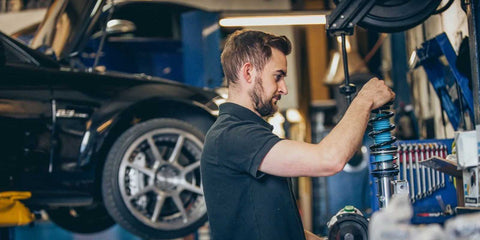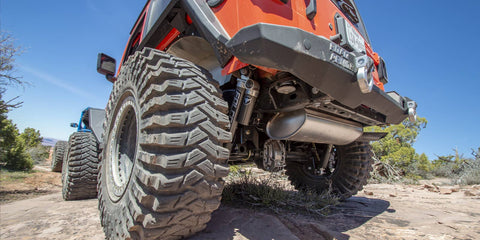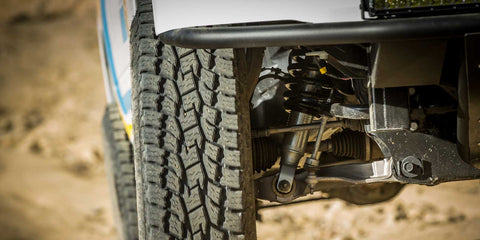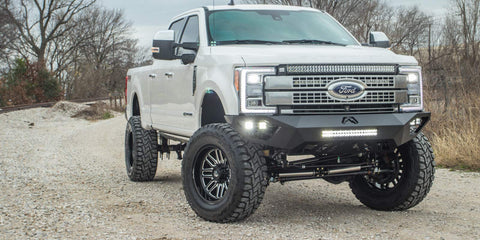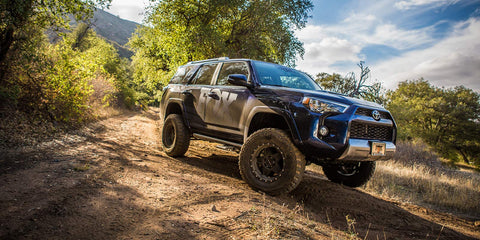Differential Drops - When and When Not To Mess with your CVs
Posted by Sean Law-Bowman on
What is a differential?
The differential on 4WD vehicles has the basic function of converting the power and rotation of the main driveshaft, to the front wheels. The differential controls how much the driver or passenger tire wheels are moving at any given point, as they are not always the same speed. In a turn, the inside wheel will be turning less than the outside wheel, the differential controls this.
A differential drop kit, at its core, is simply designed to lower your differential housing to help correct the angle at the constant velocity joints on your axles. As you increase lift height, your CV axles sit at a greater angle, and once the differential is dropped, they sit closer to flat at your new taller lift height. This sounds great on paper, however, oftentimes it is unnecessary.
The big benefit of a Constant Velocity (CV) joint is that it maintains similar strength when used within its ideal operating range. In English, that means as long as your CVs do not see angles beyond what they were designed for, the change in angle simply from the lift height alone will not cause any premature wear or failure to the joint itself. It’s all about how far you let that suspension extend; however, if you are smart about what parts you buy, this will never be a concern.
Shock Lifts vs Spacer Lifts
The vast majority of reputable manufacturers like Bilstein, Fox, King, Icon, and others ensure that their ride height adjustable coilovers and struts for most applications do not cause CV bind, by simply making sure they are the right length. The overall extended length of your coilover or strut determines how far your suspension and, therefore, your axles are being extended. This means as long as they are not too long overall, CV bind is never a concern. Simply put, if you buy a good set of coilovers and install them following the recommended guidelines, a differential drop kit is a waste of your time and money. So why might you actually need one?
When Do You Need a Differential Drop
The most common cause we see is strut spacer lifts. More often than not, the combined overall length of a larger lift spacer and even the factory struts is enough to allow the suspension to extend into CV bind territory. So, although you may be able to easily hit 3” of lift on a set of coilovers without needing to move the differential, a spacer kit of the same lift height might be bind city, all because of the additional overall length.
When you are adjusting ride height on a set of coilovers, the total extended length is the same, you are just moving where it sits in its travel at ride height.
You can argue a spacer kit may allow for more droop travel for slightly better articulation, but if your CVs are binding, not only could they be limiting that extra droop travel you think you are gaining, you are rolling the dice on kicking a shaft every time you get the rig flexed out. Let’s be honest, if you are fighting for articulation, you likely need better dampers anyway, so we think spacers are better left for your local mall parking lot. Furthermore, it is likely much of clearance you gain from adding that spacer is lost from dropping your differential.
Most differential drop kits include an assortment of spacers and hardware to slide between your differential and the factory mounting brackets. Most applications run a cross member just below the pinion of the differential and front drive shaft, so it is only possible to lower the front half of the case. This pushes the larger part of the differential housing lower in the chassis and usually means you will need to space out and lower your front skid plate or remove it altogether. This robs you of clearance where it is arguably most critical on an independent suspension rig.
One of the greatest strengths of an independent suspension vehicle is the massive amount of center clearance you get between the tires at ride height. Unlike a solid axle, the cross member that your lower control arms and differential mount to is the highest point of the undercarriage of the front of your vehicle when your suspension is at rest or extended. However, under compression, this same strength also becomes one of your greatest weaknesses. Generally, when the suspension nears its bump stops, that cross member becomes the lowest point, making the clearance you lose from dropping your diff even more detrimental. One step forward and two steps back, as the old saying goes, but our biggest gripe is not with the loss of clearance but more about trading driveline angle at one area for another that, frankly, was not designed to see angle change.
As we mentioned previously, the overwhelming majority of differential drop kits achieve most of their CV angle correction by dropping the front of the diff housing while leaving the pinion or input side alone. This puts the joint that connects the driveshaft to the differential at a greater angle, which often simply shifts the problem upstream. Unlike solid axle vehicles, the differential is stationary in the chassis and does not move with the suspension. This means there is a good chance the mothership did not spec your vehicle with joints at the ends of your driveshafts that were optimized to function with changing driveline angles like the CVs on your axle shafts. Although the data really is not there to definitively assign blame to diff drop kits, we have seen a few hardcore wheelers in Toyotas have front drive shaft failures, most of which seem to have had diff drops.
We won’t point fingers, but just about the easiest way to make any driveline component fail is to put it at an angle it was not designed for. With that said, not all differential drop kits are made the same, and despite our many niggles with most kits, there are a few applications that can benefit greatly from having one installed.
Current Lay of the IFS Vehicle Land
Some applications, such as 2022+ 3G Toyota Tundras without TRD Off-Road or Pro packages and 100 Series Land Cruisers, feature long control arms and space for large shocks, enabling respectable travel and more lift with fewer modifications. However, their high-mounted differentials and inferior CV joints limit performance.
Lowering the differential in these cases allows you to use much longer coilovers or shocks more safely, allowing for more useable wheel travel and lift height. Plus, since the differential is already sitting so high up in the chassis, there is a better chance you will be able to lower it without having to lose clearance at the crossmember and while keeping your skid plate in the same place. Recently we have also seen a lot of differential drops release that go about things in a way that we think is much better than the typical spacer kits we have been used to seeing.
Although few and far between, there are select companies making differential drops for a couple of lucky applications like Rangers and Hiluxes that are comprised of bracketry that much more safely relocate the differential as a whole rather than simply using spacers on the stock brackets to clock the front of the differential housing forward and down. This usually allows them to accomplish more drop at the diff while keeping it flatter in the chassis, thus minimizing any angle change at the pinion or driveshaft joint. Furthermore, since the whole diff is moving together, there is not the same issue of the front half of the case hanging down below the cross member, so you will likely see next to no loss in clearance. This could allow suspension manufacturers to offer longer travel or higher lift height options in the future. Still, with how few of these kits are available, we think it will be a long time before we see a plethora of “super extended travel” coilovers available for most applications.
Conclusion
Overall, the answer to whether you need to drop your differential or not for the lift you are running is almost always more complex than a yes or no. There are a lot of factors to how you set up the vehicle that really matters, but there is one easy way to ensure you never need one. On most applications, as long as you are looking at a set of ride height adjustable struts or coilovers built by a brand that knows what they are doing, your CVs will never bind, and a differential drop will never be something you need even to consider.

